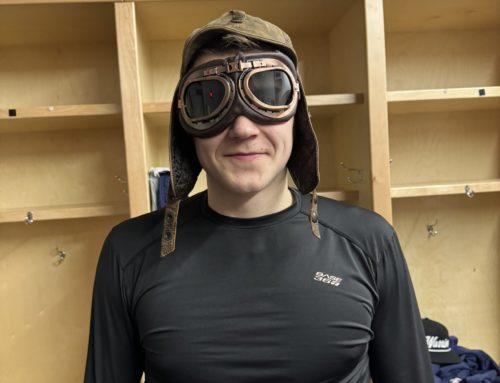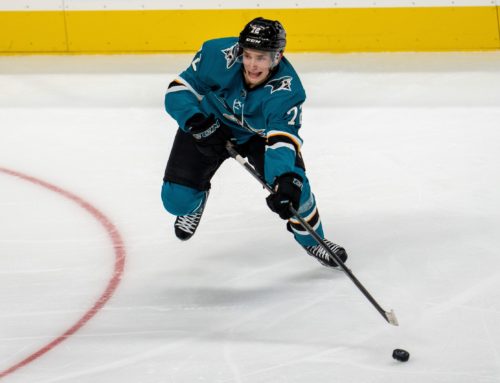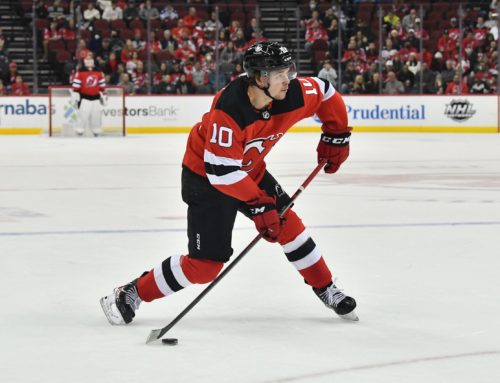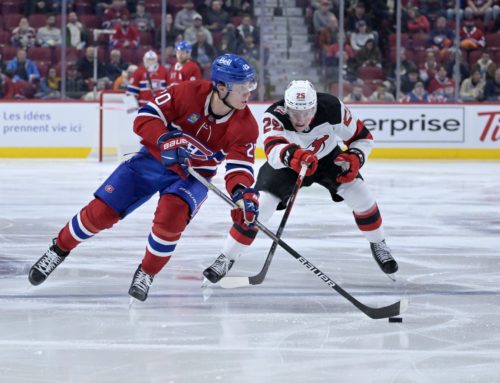The Century Mark: Matias Maccelli and Kirill Marchenko
Alex Wyatt
2023-12-01
Cover image via Union and Blue.
Welcome back for another edition of the Century Mark, where we will dive into some of the underlying numbers on a couple players who are reaching the threshold of 100 NHL games played. My aim is to help read the tea leaves to help you decide if it is worth continuing to invest in these young players.
If you read the Century Mark retrospective, where I kicked off the season by diving a bit deeper into the intent of the column and revisited my first season’s worth of advice, you’ll have noticed I had a penchant for diving into defensemen. I feel it only fair we diversify a bit and begin the year looking into two wingers who are reaching the Century Mark on solid trajectories.
Mattias Maccelli (ARI, right wing)
Maccelli, 23, was one of those players, for me anyway, who seemed to come out of nowhere. Drafted just inside the fourth round at 98th overall in 2019, the playmaking winger was rarely mentioned in my league chats, where most of the discourse was around the top-tier Jack Hugheses and Moritz Seiders, or even the next tier Philip Tomasinos and Peyton Krebses. Yet here we are, five seasons later, and Maccelli finds himself in 10th for total points from this draft, and fifth in points per game.
He didn’t first appear on my radar until his 2019-2020 season, when he led the Liiga in points from an Under-20 player, neck and neck with the far more discussed Anton Lundell. He then began popping up a bit more once he came back over to North America. After two Covid-impacted seasons, where he played in the Liiga, he came back to North America and immediately saw 23 games with the growing Coyotes, leading their AHL affiliate in scoring with 14 goals and 43 assists in 47 games.
Now that Maccelli is more of a household name and is skating towards the Century Mark, how should you approach this milestone if you roster him in your fantasy league?
First things first, Maccell is a playmaking winger. Despite having a much stronger goals-to-assist ratio in his junior years, he has matured into a pass-first type of player, as evidenced in this chart from his Frozen Tools page. His offence this season—small sample size warning—is tracking a similar path as last year with near identical point pace and a similar ratio of goals to assists.
With Maccelli, this assist-heavy offense is the main production he will provide your squad, as thus far in his career he hasn’t shown a penchant for PIMS, and though he’s shooting a bit more thus far this season, even two shots on goal won’t be enough of a category filler to usurp an incumbent winger (Mikko Rantanen and Artemi Panarin each have 3.6 SOG per game at writing), and his hits are very minimal as well.
The impact of a player’s deployment can get lost in the noise sometimes with these types of counting stats. I used Rantanen and Panarin as examples—Panarin being more of the playmaking mold himself—of players who have more SOG per game than Maccelli, but one would expect both veterans are seeing more ice-time per game than the young Coyote. It seems only reasonable to expect a player who plays several minutes more per game, and in more offensive situations—offensive shift starts, power plays for example—to have more shots on net in a game. This is when some of the Compare Tools on Frozen Tools become your friend.
I added Maccelli, Panarin and Rantanen into a comparison tool, and I am now able to hone in on these three players and compare a whole host of statistics in a compact manner, one of the most important here being their ‘per 60’ stats. This normalizes a player’s production across 60 minutes of playtime, allowing for a more fair comparison to be made between players with different deployments.
A player will only provide the stats they accumulate in total to your team. I’m sure leagues utilizing ‘per 60’ stats are exceedingly rare, but this does give us a bit more of a glimpse as to a player’s production on an equal measure to other established players, and allows us to surmise how Maccelli’s SOG could increase with more ice time, and where that increased production would stack up among veterans if the deployment increased. I wouldn’t hold my breath waiting for Maccelli to become the next Rantanen or Panarin, but as the Frozen Tool report shows, there tends to be a different feel to ‘per 60’ stats than gross counting stats.
In his draft year, Maccelli was not among the top names on the board and did not project terribly strong from Hockey Prospecting’s assessment.
Though his star and NHLer probability—the likelihood that a player hits a 0.7 PPG pace as a forward or 0.45 PPG as a defensemen, as well as his likelihood to play 200 NHL games—look low on the chart above, he aged out of the model in his Draft+3 year. Even his last year in the model, where he went more than a point per game in the AHL, showed growth, and since he entered the NHL his career average is 53 points per 82 across 101 games played as I write now. Dropping off his first 23 game stint in 2021-2022, he’s managed a 0.74 point per game pace, which is technically star-level by the model. It’s safe to say he is a near lock to play 200 games given his performance thus far in his career as well.
So far this year, in just 14 games this season, his deployment is seeing a natural progression, seeing a slight uptick in points per game, and stable deployment on special teams as he saw last year.
His deployment numbers sit similar to last year, and so do his linemates, as he saw the vast majority of his minutes at even strength with Lawson Crouse and Nick Bjugstad. This year is more of the same, as he has played 45.5% of his 5 on 5 minutes with together with those two. As Arizona brings its well-stocked prospect cupboard content up to the pro level, it will potentially give him the opportunity to play with more dynamic offensive linemates.
The only knock on Maccelli that would weigh on my mind would be his lack of peripherals, and would an assist-heavy glass cannon be an asset or liability on your team?
I’ve traded Maccelli with some other futures for Steven Stamkos in one of my leagues where I was contending. If you can trade Maccelli in a similar fashion for an established piece that will help put you over the top—you should always be in the mood for something like that if you’re close—perhaps he’s a movable piece. Otherwise he’s a solid 60-70 point threat with an assist-heavy, peripherals-light build, and in most leagues is a solid keep.
Kirill Marchenko (CBJ, right wing)
Marchenko, 23, arrived with plenty of gusto last year, being a front runner for the NHL’s version of the Cy Young award in his rookie season. He scored 13 goals before he (possibly accidentally) garnered his first assist, finishing with 21 goals and four assists on the year in only 59 games played. On a team that has had a number of long-term injuries to stars, key underperformances, and lost more than twice as many games as they won, Marchenko gave Blue Jacket fans and poolies alike plenty to be excited about. As he gets into the groove of his second, more balanced offensive season, and rounds the bend to the Century Mark, what do those of us who scored him onto our squads last year have in Kirill Marchenko going forward?
In 2023-24, Marchenko has decided to share a bit more than last year, surprisingly sitting with as many assists as goals, with six goals and six assists through 21 games.
He’s still shooting more than two shots a game, sitting at 2.7 per game thus far this year, though his shooting percentage has tempered somewhat from 16% last year to 9.3% thus far this season. He barely threw half-a-hit per game last year and has dipped below that mark this season, and seems to stay out of the box quite well, with nary a quarter of a PIM per game this season or last.
Marchenko’s ice time is nearly the same as last year, with 15:54 in ice time per game this year and last, with just under three of those minutes coming on the powerplay.
He saw the vast majority of his ice time last year with Johnny Gaudreau and Boone Jenner, essentially becoming the trigger man that was supposed to be Patrik Laine, while also taking turns with fellow youngsters Kent Johnson and Cole Sillinger.
Kent Johnson and Cole Sillinger both received more fanfare from their draft year onward than Marchenko, but the two have both seen themselves demoted to the AHL—which Johnson is currently destroying—while Marchenko has, as mentioned, been consistently deployed at the pro level. He is still seeing time with Gaudreau and Jenner, and playing with this year’s kid line of Adam Fantilli and Dimitri Voronkov.
The nice thing about the line combinations tab, is it drills down to who is playing with whom at even strength, showing how many minutes and what percentage of the play you are tracking’s ice time. Further down below what I have shown above at even strength, you can see the powerplay variety the teams use, and if your player is getting any ice time with some better known stars, or conversely, if any lesser known names start to show up in the mix, you could add them to your watch list.
Now that we are far enough along in the season, we can use one of my favourite pieces from Frozen Tools, the player usage chart.
To reacquaint those who are familiar and introduce those that aren’t, the Player Usage Chart is a visualization of players’ deployment, both raw and relative, with a number of metrics presented at once.
First off, the height at which a player appears on the Y-Axis would indicate that player’s ‘Quality of Competition’ they are facing, measured by Corsi For (shot attempt share while on the ice). That Marchenko finds himself beneath the horizontal line suggests he is being sheltered by facing a lower quality of competition, which would be a great place for a young sniper to develop.
His position to the far right of the X-Axis suggests he starts far more than half (the vertical line in the middle is halfway, as represented by the numbers at the bottom) of his shifts in the offensive zone. The size of his circle indicates the relative ice time he receives, with larger bubbles meaning more ice time. Lastly, the colour of the bubble denotes his relative Corsi For, with his grey hue suggesting he is middling in that stat, while most of the Blue Jackets on the chart have negative measures.
Feel free to play around with this tool by changing the positions tracked, the minimum thresholds for ice time, and even add multiple teams to see which players’ bubbles tend to stand out from the big pile of data-spaghetti that collects as you track more teams. Below is every team added, with Marchenko being the player we are tracking so he is highlighted despite being in the middle of the horde. You can use something like this to see which players stand out from the pack, and then dive in on them to find out why. We see you there, Roby Jarventie.
Shortly after being drafted 49th overall in 2018, Marchenko rose from the lower levels of Russian hockey and made his mark in the KHL as a 19 year old.
He led all U19 players in goals, assists and points, with a 7/9/16 stat line in 31 games. The following year he led in point per game pace by players his age or younger- being beat in bulk scoring by Ivan Morozov, who played more games, and the next year was fourth when filtered by his age or younger. It’s important to filter by age when measuring young players in the KHL, as some teams in the league have a habit of playing their youngest players mere minutes per night—see Michkov, Matvei—though Marchenko appeared to have avoided that fate.
His Hockey Prospecting chart did not start off with the makings of a superstar, but the upward trajectory shown through his progression through his KHL career showed the type of growth you want to see in a ‘next tier’ prospect. If the growth is consistent and linear, it generally can be relied on more than a player who has one big blowout season out of nowhere and doesn’t replicate that magic the next.
Marchenko aged out of the model in his D3 year, and by then the model had picked up on him. He’s averaging 0.46 points per game and trending up, and seems a lock to play another 120 NHL games to satisfy the ‘NHLer’ requirements of the model. Though none of the comparisons in the Full Comps section instil a lot of excitement, they are all pros who put in decent enough careers. Byron Bader has noted many times that the KHL, and most Russian leagues for that matter, are hard to derive comparables from.
Marchenko has performed very admirably since entering the league as a rookie, building on a solid framework he began in the KHL. Though the Blue Jackets seem to be a team that often underperforms their talent on paper, Marchenko has been consistent, and given consistent deployment. He’s already a solid contributor, though not a superstar in fairness. His 6-3 frame may even mean his breakout threshold will arrive at 400 games vs 200.
For me, he’s a keep in every league I own him in, and though I don’t expect him to win the Rocket Richard, he looks to be a shot-producing, goal-scoring winger, and those players are always valued at a premium. As always, if you can flip him for someone who can put you over the top, if you are in that stage of the competitive life cycle, you might be able to score an aging point-per-game player for him. If the Marchenko owner in your league is in that position themselves, perhaps you might be able to pluck him away as a piece that will have more longevity for your squad.
Thanks for checking in again to the Century Mark. I hope I’ve helped explain some of the tools you have at your disposal with these players as examples, and given you some insight on these two exciting young wingers.






